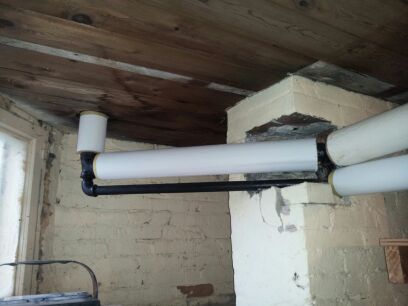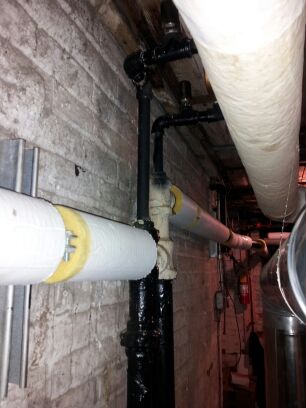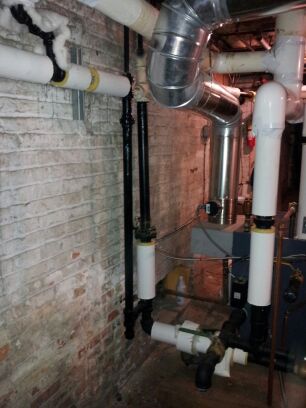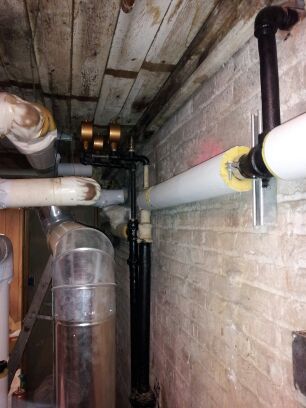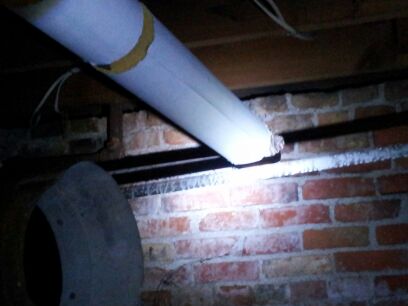Welcome! Here are the website rules, as well as some tips for using this forum.
Need to contact us? Visit https://heatinghelp.com/contact-us/.
Click here to Find a Contractor in your area.
If our community has helped you, please consider making a contribution to support this website. Thanks!
main vent reopening temperature
Options
Comments
-
You have to factor in, for each radiator vent, how much volume of air it has to expel. That's the sum total of all the internal volume of the runner piping from the main plus the internal volume of the radiator. Are you selecting the size of the vents for each radiator with that in mind? It helps to have the Gill and Pacek ebook as a guide.1
-
The lengths stated do not include the returns.
One riser but then it has an intermediary loop before rising again to the header. This can and has been debated but in the end my steam seems to be dry. No spitting anywhere.
I've gone through the pitch of the returns and they seem all OK. What however is the proper pitch on the mains and the supply branches?
What I notice on the North circuit is that when the Gorton gets hot and shuts off half of the north returns are hot and the other half ice cold. The hot ones are what I would say are the "short path" circuits. I.e short distance back to the end of the return riser from where it splits off the supply branch. The north circuit has 3 of these "short paths" which are shorter than the shortest such path on the South circuit.
Remember I am really still only talking about trecoveries from setbacks here. The system works smooth and nice while holding temperature even in very cold conditions. I would be interested in others experiences if they force a 2 to 4 degree recovery on their system. Maybe my experience is not so unusual.0 -
What I notice on the North circuit is that when the Gorton gets hot and shuts off half of the north returns are hot and the other half ice cold. The hot ones are what I would say are the "short path" circuits. I.e short distance back to the end of the return riser from where it splits off the supply branch. The north circuit has 3 of these "short paths" which are shorter than the shortest such path on the South circuit.
This is a 1 pipe system right? When you say "half of the returns" Do you mean half of the radiator suppy runs?
To answer your question about what others who force a 2 to 4 degree set back experience: I used a 3 degree setback for several years before I decided it wasn't saving me anything (I know there is much debate about this subject) Your situation is not typical of a setback. The only difference I ever saw in the setback process was short cycling before the Thermostat was satisfied.
Back to your comment about the Gorton vent closing while half of the runs are still cold, two things come to mind, 1) either you have the radiator on the hot runs so wide open that they become the "path of least resistance" or 2) and I suspect the most likely problem because the vent should only be getting heat from steam coming down the Main and if that half is still cold, obviously not the case. I'm thinking you either have that Gorton so close to the vertical drop to the boiler or that your pressure builds enough that it pushes boiling water up that verticle return heating the vertical enough that that closes the Gorton. You end up with steam pusing air in one direction and water pusshing air back the other direction and the venting can't handle the volume but there is enough heat to close the vent. Is that a possibility?0 -
"I would be interested in others experiences if they force a 2 to 4 degree recovery on their system."
With regard to what aspect of it? I do a 8 deg setback on mine every night. Sometimes it doesn't get down that low and the boiler doesn't fire at all, other times it has to.
If your "issue" is with lack of even heating, once you get the tstat sensor so it is actually sensing avg. house temperature, the only way to solve that is with balancing of radiator sizes and vent sizes.0 -
The question on the setback is whether it is typical to short cycle on pressure (whether you have your pressuretrol cutting out at 1.5psi or as high as 3psi ...knowing that it shouldn't be allowed to get up to 3psi). Right now my only real "issues" are pressure getting higher than the pressuretrol says it should and end of cycle vacuum hiss. I still need to look into my thermostat fuctionality and try recalibrating the pressuretrol.
Fred, I will attach a couple photos of a typical portion of supply and return on my system. There may be some misunderstanding of the arrangement or definition thereof. I defined it as one pipe because there is only one pipe going into and coming out of the radiator. The returns, other than the initial drop, are independent of the supplies and lead back to the risers behind the boiler on which the main vents are located. It is not a counterflow one pipe system but still I think a one pipe system?
BTW the second #2 on the South line took about 15 seconds off the time to closure of the North Gorton and about 40 seconds off the time to closure of the South line Gorton. South rads get to 50% between 10-19min and north rads to 50% between 20-25min. I did some radiator vent tweaking as well.
0 -
-
Take a picture of the radiator so we can see how they are set up. Also, take a picture of where the returns tie together. I'm not sure you are getting the full advantage of the main vents on the returns with this set up. Otherss will have a opinion. @jamie Hall would be a good man to advise on this.0
-
I'm hoping @jamieHall or @jstar will chime in and advise of the best place to put your Main Venting. With this configuration, I don't see how the vents at the end of the Returns can be very effective. I suspect that's the whole problem you are experiencing.0
-
I suspect they have been there for 125 years. There is no obvious place where they would have been at the main ends. Before I put the antlers on there were just single main vents at the top of those two vertical risers before the new elbows.
If you look at the times to get steam to the ends of the mains, they aren't too bad.0 -
They probably have been there since the beginning. The issue is, in the day of coal fuel, the boiler just simmered all day and didn't really build any pressure. Now that we use gas, the boilers can build pressure, and, with an over-sized boiler to add to the situation, having the vents at the return near the boilerwhere, essentially all the "Drip Legs" come together isn't a very good way to vent the Mains. I mean the steam is actually pushing the air into those drip legs, that are also filled with air and you have provided some escape with the vents but it just isn't the right aapproach to speed steam into the mains and distribute it in a balanced way to all the radiators. I'm sure Jamie or Jstar will weigh in. Let's juust get their vview and you will have a good feel for how best to vent those mains effectively.0
-
The vacuum hiss of the radiator vents is pretty unavoidable, except to have radiators so large that the vents don't even close on recovery, which would not be feasible to do so. When the vents first start to crack open, the orifice is very small, thus the hiss. The faster the vent opens the less the effect, so it may vary from one vent design to another. My varivalves do it pretty loudly, but it only lasts a second or two.0
-
While the mains are open they define the path of least resistance therefore my system must evacuate air out of all the mains, branches and returns before both main valves are closed and the path of least resistance subsequently becomes the radiators. In practicality, this is not entirely true because I do start getting some heat in some of the radiators before the south line main has closed, but, on the surface it seems I need to clear a higher volume of air away before heating radiators than if the main vents were at the ends of the mains . If the vents were at the ends of the mains and closed there wouldn't be any need for steam to enter the returns unless steam production outpaced the venting capacity of the radiators.
It would be very interesting to cap off those returns and add vents at the main ends. It is possible somewhere along the way in the past 125 years someone did change things a bit. The north line for instance goes through the north wall of the basement into a nasty 3ft high crawl space area. At what I would define as the end of that north main there is an reducing elbow with a line continuing on to the parlor (stat room) radiator, but, that elbow has another fitting almost like a T capped off. Perhaps there used to be a main vent there that someone decided was in too inconvenient of a place. At the end of the South main there appears to be what looks like either an old steam trap or more likely just a big old T-type fitting with a big plug in the top and the condensate return pipe coming out the bottom. Maybe there was a main vent on top of this? Not much headroom for a vent here though and there is a new gas line going right across the top of it.
0 -
-
It sounds like you may well have found where vents were. If not, those are exactly where they should be to get the Mains vented like you need. Is there any way to re-open them and move your vents to those locations? If you can, you can use plugs at your returns where you have them now. I think you'd see a huge improvement in performance.0
-
If the north system as it is now is getting steam to the end of the main in about 3 minutes at which time (for whatever reason) the main vent at the end of the north returns is also getting steam and closing almost simultaneously, then maybe I need not do anything with that side of things. Call it lucky if not good.
South side might be worth tinkering with. Likely not till spring though. Nonetheless there is a branch that begins about two feet from the end of the South main that is truncated and capped after about a 5 foot run. It would be a very convenient spot to put a main vent. Just not sure I want to mess with the 1.5" cap on that old pipe right now.0 -
When you fix the South side, and create a nice easy path to vent air, the North side, if left alone will then become the problem. Do yourself a favor and take care of both of them at the same time and be ready to go next season.0
-
Below link is a similar discussion you and I and Bob were having last May. We never really questioned the location of the main vents at that time (title question of the thread). The thought was they were OK.
Perhaps this does warrant some further discussion.
http://forum.heatinghelp.com/discussion/150613/end-of-return-venting#latest0 -
Yep, the difference between that discussion and this one is what you really have are a bunch of Drip legs, not what we typically call "Returns" that is a continuation of the main, after the last radiator run albet possibly a smaller diameter pipe running back to a point wher it drops down and into a wet return.
While yours are returns, in thaat they return condensate to a wet return, they do so from multiple points off of the Main.0 -
I'm not sure what you mean by "they do so from multiple points off of the Main". Either you have counterflow through all your supply branches or you are going to have separate returns from each radiator feeding into the main return lines (as I have).
How would you define my system? Would you call this a two pipe?0 -
You have a 1 pipe system because you only have 1 pipe that feeds steam and return water back to the main. What appears to be somewhat different in your system (at least from the pics that i see) is that you have Drip legs that carry water back to the boiler seperate from the Mains. Most don't have those drip legs (unless they are draining a low spot or section of pipe). The typical 1 pipe system (if there is such a thing as typical) the Main loops around the basement, back to the boiler and carry the water back to the boiler through the same Main as carries the steam, all the way to the end of the Main at which point the Main, (after the last radiator run) becomes the dry return and drops into a wet return at some convenient point in basement and that wet return then goes back to the Hartford loop at the boiler.
0 -
Could it be considered a two pipe system because in reality in my system there is no water going back to the boiler through the mains. If I interpret Wikepedia correctly it could be defined as a 2-pipe direct return.
http://en.wikipedia.org/wiki/Hydronics
However, reading Dan's "We Got Steam" book it really doesn't fit either definition since we are certainly venting at the radiators and at least initially for a foot or two condensate does initially leave where it came in. It simplifies the assessment to the radiator configuration.
I guess I have a 1 1/2 pipe system
Perhaps should there be traps on this type system. Maybe steam should never enter my dry returns???
0 -
No it is definitely a 1 pipe system, as defined by only 1 pipe to each radiator that carries both steam and return condensate back to the Main. The install just uses a seperate drip leg to carry that condensate back to the wet return. That is not so different from a Main that loops back towards the boiler and becomes the dry return just probably a little less expensive at the time it was installed (using smaller return pipe than carrying the Main/Dry return back around in a loop).
It isn't an issue with steam as there is normally air in those drip legs and if you think about it, even the looped Main that becomes a dry return will allow steam into them if they are vented at the end of that return (as a matter of convenience in placing vents).
Traps are not required. It's just in your set up venting at "the end of the returns" was suggested for the more traditional model. None of us realized your returns were drip legs. However, as you have seen it still improved getting steam down the mains but just isn't the most effective way to get full advantage of those vents. (we should have asked for pictures in the first discussion).
You have located where the vents use to be and those locations are ideal for venting the Mains. once you move those vents to those locations and plug the current location, those drip legs will be filled with air and steam won't even be able to get into them.
I have a drip leg, on my system, where the Main transitions from 4" down to 2.5" and it just isn't an issue.0 -
Sorry... I haven't been paying attention...
I'd leave the vents where they are -- they aren't doing any harm. But. I wouldn't add any more venting there; you need a small amount of pressure (granted, only an ounce or two -- but you do need that) in the steam mains, otherwise the steam will just follow the mains around to the vents, and this is one of those situations in which too much venting on the mains is probably not a really good thing. Given just a little pressure, though, it will go to the radiators quite happily. If you really need to speed things up (and seems to me that you are doing pretty well as is) you could find places on the two mains just after the last radiator runout on each one, and add venting there.Br. Jamie, osb
Building superintendent/caretaker, 7200 sq. ft. historic house museum with dependencies in New England0 -
Sorry... haven't been paying attention.
I think I would leave the vents at the ends of the "returns" as they are -- I certainly wouldn't add any more there. This is one of those odd situations where too much venting is not a good thing. You need a small amount of pressure in the mains -- an ounce or two is ample -- or the steam won't bother to go to the radiators at all. If you really want to speed things up -- and I confess that it seems to me you're doing pretty well as is -- you could put additional venting on the mains, just past where the last radiator runout leaves. Those vents would close when steam hit them. It seems to me, though, reading through all this, that you won't gain much that way.Br. Jamie, osb
Building superintendent/caretaker, 7200 sq. ft. historic house museum with dependencies in New England0 -
It wouldn't seem to me that adding vents at the ends of the mains would do much if vents remained at the ends of the returns. Once the vents at the ends of the mains closed (which would be likely just a little less than 3 minutes since I am already at ~3 minutes to get steam to the main ends) then the path of least resistance would still be all the way down the return to the main vents waiting there. My thought is that maybe I am losing 5 or 6 minutes waiting for the primary return line on the south circuit (which is a long 35ft 1.5" pipe) to fill with steam before it closes that main vent because the steam is going to favor that path over the one to the radiators because the radiators have less venting. If a main vent were positioned at the end of the main and the return unvented, then, air at that point followed by steam might want to go to the radiators instead of down the return. With a couple longer branches off the main maybe it wouldn't be that much better in the end, I don't know.
If you think the times I have listed previously for getting heat into the radiators is reasonable then I probably shouldn't worry too much about this.0 -
As I said earlier, to get the full benefit of those vents, I'd move them to the end of the Mains now that you have found where they probably were originally. Besides, that saves some money rather than but more vents. I think you'll see some improvement, especially with more even times to get heat to all radiators.0
-
If there are no radiators being fed from the return line -- as opposed to being fed by a steam main (this is a return line we are talking about here?) who cares if it's air or steam in it? Makes no difference at all. If you are only taking threeminutes to the ends of the mains -- past the last radiator -- I'd say you are doingjust fine. Leave it be.Br. Jamie, osb
Building superintendent/caretaker, 7200 sq. ft. historic house museum with dependencies in New England0 -
@JamieHall His problem is that half of 1 main gets the radiators steam hot while the other half of the radiators are stone cold and the vents are not where they originally were. I know the vents at the end of the return is not a problem but it appears that 1 main simply isn't venting well and I thought if he moved the vents back (rather than buy more) he'd probably do better. I think he said his North Main is getting steam in about 3 minutess but his South main takes about 6 minutes.0
-
Please check the latest data. N and S radiator filling times are reasonably close with latest trial including two #2's on the South and a little radiator venting alteration. Time to the ends of the mains on both the S and N line are not far apart and close to 3 minutes. The difference between the N and S is the time at which their main vents close. The main vents on the North line (even though located back at the boiler on the return) close at about the same time steam gets to the end of the main ( so steam is going into the returns before reaching the end of the main in order to close it). The S line main vent (also back at the boiler) doesn't get hot and close until 8 or 9 minutes. I think the point Fred and I are making is that as steam is traveling down that long S return I could instead be pushing steam toward the radiators if the main vent weren't at the end of the return.
I agree that things aren't that bad and I am not planning any major winter plumbing. Might play around a little in the Spring.
Jamie, have you run across systems in the past with this "drip leg" return format? Is it that unusual?0 -
Just a footnote. I did open up one of those two closed upstairs bedroom radiators. I also throttled it down with a low vent rate air valve (#4 orifice Maid-O-Mist that was lying around in the basement). I think it does help significantly in allowing the system to run longer and maintain lower pressure. I think if one can afford to have a radiator not heat as quickly as the others (by a significant margin) it creates somewhat of a "buffer". While the main living quarters and stat room are warming up on a long recovery cycle this buffer radiator fills very slowly. Once all the other radiators are 100% full and the stat still wants more heat, this is when pressure will have the tendency to rise. By having this buffer radiator still slowly venting it seems to allow the system to keep pressure down by still having some escape path for additional air thus allowing for a longer on cycle.
After doing this I do not see pressure rise to more than to 0.5psi on my 2 degree recoveries and of course no cycling. Only remaining small nuisance is that I still seem to have some significant whistling of air inrush after the heating cycle finishes even though no significant pressure was generated during the cycle. I wonder if some valve types are more susceptible to this than others. All of my valves are Hoffman 1A's with the exception of the aforementioned.0 -
Any excess capacity that your boiler has to replace the condensing steam in the main floor radiators will still be going to that smaller vented radiator. Because it is not using as much steam with the smaller vent (smaller orifice, more back pressure) and can't let the air out as fast, the whole system will actually be at a higher operational pressure than it would be if you had the higher capacity vent (larger orifice, smaller back pressure). It is true that you are much less likely to hit the cut-out on the ptrol though, since that radiator takes much longer to fill. The question is, which scenario uses more fuel to satisfy your tstat during recovery? If the ptrol cuts out, the boiler is firing for a shorter amount of time during recovery. I think you'd have to check your gas meter before and after the setback period, with and without that smaller vent to find out (and do a number of trials).0
Categories
- All Categories
- 87.3K THE MAIN WALL
- 3.2K A-C, Heat Pumps & Refrigeration
- 61 Biomass
- 429 Carbon Monoxide Awareness
- 120 Chimneys & Flues
- 2.1K Domestic Hot Water
- 5.8K Gas Heating
- 114 Geothermal
- 166 Indoor-Air Quality
- 3.7K Oil Heating
- 77 Pipe Deterioration
- 1K Plumbing
- 6.5K Radiant Heating
- 395 Solar
- 15.7K Strictly Steam
- 3.4K Thermostats and Controls
- 56 Water Quality
- 51 Industry Classes
- 50 Job Opportunities
- 18 Recall Announcements

